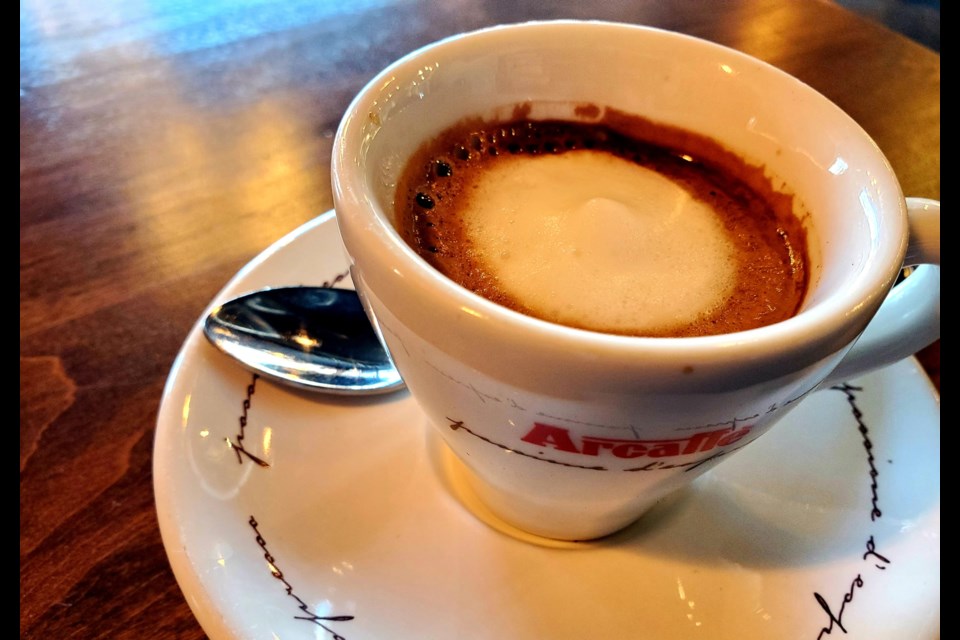I am back in Italy for the first time post-pandemic and writing from Bari, Puglia.
Two weeks ago when I arrived in Rome Fiumicino airport the first thing I searched for was an espresso. For coffee lovers, there is nothing like an Italian espresso to wake you up after a long red eye flight from Toronto to Rome.
The coffee bars are always easy to spot as there is usually a line and a hub of activity. For tourists arriving in Italy for the first time the coffee bar experience may seem a little daunting. You simply line up and pay the cashier for your request and then take the receipt to the barista at the counter. The barista may also present you with a small glass of water and then your espresso. No time to sit down. First cleanse your pallet with the water. Now, just add sugar if you like to your coffee and down it in one or two drinks. When in Rome, do as the Romans do!
My first experience with coffee, I was quite young as Italians don’t typically consume a hearty breakfast. As young children growing up in an Italian-Canadian household our daily breakfast consisted of latte cafe and my mom’s homemade biscuits. Latte cafe is about a quarter espresso coffee to three quarters milk, heated in a pot and sweetened with sugar.
We would dunk my mom’s biscuits in the latte cafe and then off to school! The adults had an adult version with little or no milk at all.
In Italy today this is still the typical breakfast. An espresso or cappuccino and a brioche or croissant. Most are consumed on the run, at the local coffee bar, standing.
In North America where a typical cup of coffee is eight ounces or more, served with optional cream and sugar, the Italian versions may seem foreign to the uninitiated.
They all start with espresso coffee which was born in the early 20th century, Italy, when the first espresso coffee machine was invented. It was developed as a means to simply prepare coffee faster. The method of adding steam pressure not only made the brew faster, it was stronger.
The espresso machine did not arrive in North America until 1927 in New York City. From there it expanded throughout North America with a lot of growth in the 1950s modern era with artists, poets and intellectuals picking up on this European coffee trend. According to Zuccarini Importing Company Ltd. of Toronto, Canada’s very first espresso machine arrived in Toronto in 1954 when Giacomo Zuccarini opened The Sidewalk Caffe at Yonge and College streets.
Here in Guelph it was not until the late 60s that downtown had its own Italian coffee bar. Giuseppe Bombino, my father who was affectionately known as 'Joe', opened Guelph’s first coffee bar offering espresso and cappuccino; The Bar Perla Nera on Quebec Street. (It was located on the portion of Quebec Street that is now the Old Quebec Street Mall).
Not surprisingly, it attracted Italian immigrants craving the Italian ritual of meeting at the local coffee bar for the latest gossip and their caffeine fix. My father, now in his 89th year, recalls in the early days that these beverages were also very popular with non-Italians.
“About 50 per cent of my customers were non-Italians, many from the University of Guelph or others that had travelled to Italy.”
For 20 years Joe was a fixture downtown Guelph with four different establishments that always had an imported Gaggia espresso coffee machine at the heart of the business.
In the 1980s, Starbucks opened its first coffee shop in the United States and then in 1987 it arrived in Canada. It was during this time that the Italian coffee culture really became more mainstream. The rest, as they say, is history.
A single shot of espresso coffee is one ounce. A double, two ounces and so on. A cappuccino is typically one ounce of espresso, one ounce of hot milk and one ounce of foam.
There are many variations such as a macchiato, which is one ounce of espresso plus one ounce of milk foam or the corretto, which means corrected. A single ounce of espresso is combined with grappa, sambuca or brandy.
An Americano is a weaker version of the espresso with hot water added to a shot of espresso. The North American latte is similar to what I grew up with but in Italy if you ask for one, you will simply get a glass of milk.
The Italians are particular here about the rules. Italians will only consume a cappuccino before 11 a.m. as it is considered a breakfast beverage. If you order one after that, it is a sure sign that you are not a local.
Back home in Guelph I spoke to Kevin Polach, co-owner of Capistrano Cafe for 10 years. Capistrano offers a full espresso menu at its St. George's Square location.
Polach told me traditional Italian coffee beverages are very popular with the older, well-travelled clientele. The latte is the most popular beverage amongst the younger crowd.
I can attest to the authenticity of their macchiato, my espresso of choice. It was delicious and the foam thick and rich. They use a Toronto-based espresso coffee company that uses imported coffee beans.
Even if you don't venture to Italy you can still enjoy authentic Italian coffee beverages thanks to that iconic espresso machine now found all over the world.


